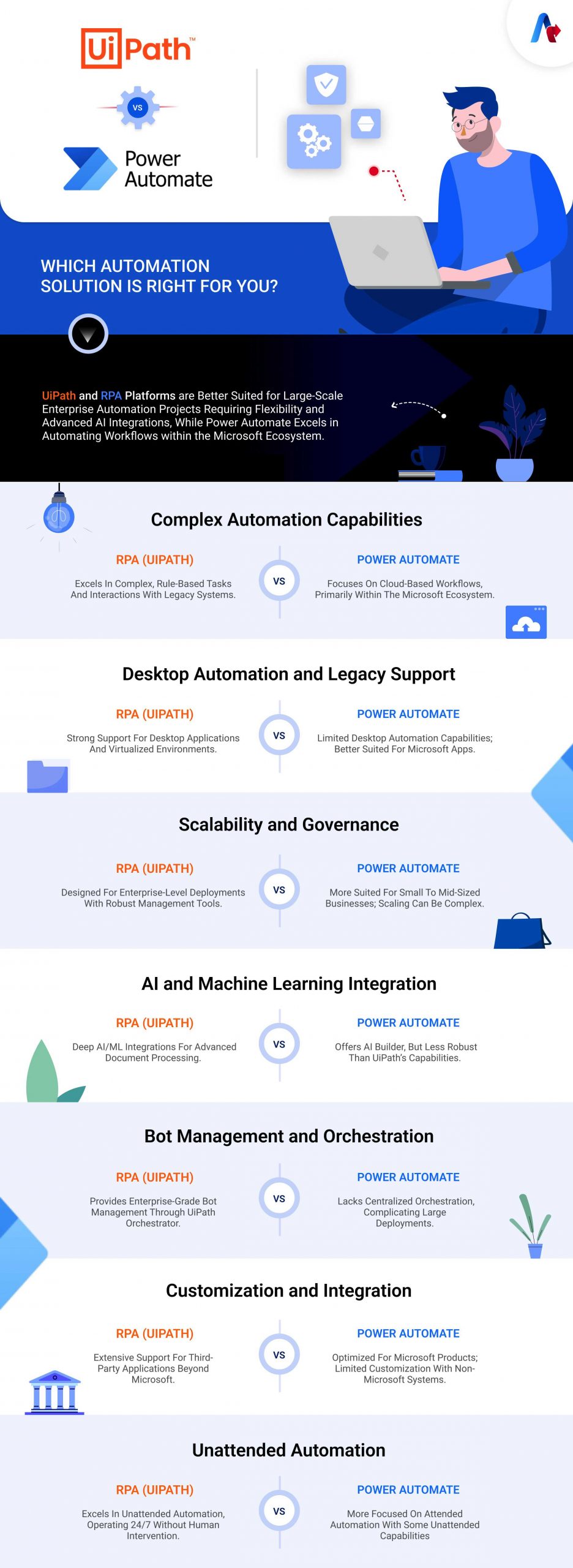UiPath vs. Power Automate: Understanding the Difference and Impact
When it comes to automation enablers, selecting the right technology and tech partner can significantly impact the operational efficiency of your organization. While both UiPath and Power Automate are well-liked choices, their functions are distinct. Complex workflows, particularly those involving desktop apps and legacy systems, are well-suited for UiPath's capabilities. For businesses searching for a highly configurable solution, it's perfect.
However, Power Automate excels within the Microsoft ecosystem, providing simple automation for operations that are cloud-based. Companies or teams that already use Microsoft products like Office 365 or SharePoint would find it to be a good fit. But let’s explore them both in detail for a fair understanding and better judgement.

1. Complex Automation Capabilities
RPA (UiPath): RPA excels in automating complex, rule-based tasks that require interacting with legacy systems, desktop applications, and various types of user interfaces, including Citrix, virtual environments, or terminal applications. RPA bots can handle intricate workflows that may include dynamic decisions and advanced logic.
Power Automate: Power Automate RPA is generally more focused on automating workflows that are located on the cloud, particularly those that are part of the Microsoft ecosystem (such as Dynamics, Office 365, and SharePoint). Even though it can integrate with a wide range of services and apps, it might not be capable of handling desktop apps, more intricate workflows, or non-standard or legacy systems.
2. Desktop Automation and Legacy System Support
RPA (UiPath): UiPath can automate tasks across multiple platforms, including Windows-based desktop applications, green screens, and virtualized environments. It's particularly strong in handling environments where direct API access is unavailable or unreliable.
Power Automate: While Power Automate Desktop adds some desktop automation capabilities, its strength lies in cloud-based services and Microsoft apps. It doesn't handle legacy or virtual environments as smoothly as full-scale RPA tools like UiPath.
3. Scalability and Governance
RPA (UiPath): UiPath is designed for enterprise-level deployments with capabilities for scaling across thousands of bots. It has built-in orchestration tools, robust logging, monitoring, and governance features that make it easier to manage large automation environments.
Power Automate: Though it has scaling capabilities, Power Automate RPA is often better suited for individual users or small to mid-sized business automation. Managing large deployments of flows may require additional effort and complexity.
4. Advanced AI and Machine Learning Integration
RPA (UiPath): With built-in Document Understanding, Natural Language Processing (NLP), and the capacity to build custom ML models, UiPath enables seamless integrations with AI/ML services. It can handle complicated data, unstructured documents, and photos more skillfully with its AI Fabric and Document Understanding toolsets.
Power Automate: While it provides AI Builder for AI integrations, particularly for activities like intelligent document processing, the capabilities might not be as strong or enterprise-ready as those offered by UiPath's AI-driven automation.
Looking to learn more about UiPath RPA?
Contact Us Today!
5. Bot Management and Orchestration
RPA (UiPath): UiPath Orchestrator provides enterprise-grade bot management and administration. Administrators can schedule, track, and improve bot performance with it, which makes it ideal for overseeing a large fleet of bots in various processes.
Power Automate: Managing a sizable bot workforce is more difficult with Power Automate since it does not offer the same level of centralized bot orchestration and monitoring as UiPath Orchestrator.
6. Customization and Integration with Non-Microsoft Systems
RPA (UiPath): UiPath enables highly configurable automations outside of the Microsoft ecosystem thanks to its extensive support for a variety of third-party programs, such as SAP, Salesforce, Oracle, and many more.
Power Automate: Designed primarily for Microsoft applications, Power Automate can be used to optimize Microsoft applications. While it does integrate with third-party apps through connectors, its customization options may be more limited when dealing with non-Microsoft systems.
7. Unattended Automation
RPA (UiPath): UiPath excels at unattended automation, allowing bots to carry out activities based on schedules or triggers 24/7 without the need for human intervention.
Power Automate: While Power Automate Desktop allows for unattended automation, its primary focus is on attended automation, which necessitates user engagement, and cloud-triggered automations.
Read More: Top Power Automate Use Cases and Examples





